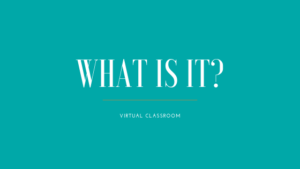 What is a Virtual Classroom?
What is a Virtual Classroom?
In my previous blog, I referred to the virtual classroom used in conjunction with inlingua Online Learning (iOL). In this blog post, I am going to be looking at the virtual classroom itself. Technical details will be dealt with in the next blog post.
There are various forms of virtual classrooms . These may include non-trainer classrooms such as iOL, classes given to groups using a large single screen or trainer-led, computer-based classes attended by one or more learners. What I am referring to here as the inlingua virtual classroom is the latter.
Lessons are conducted in the inlingua virtual classroom in much the same way as in the live classroom. The inlingua method is very well suited to the virtual classroom environment as it is principally speaking-based. The trainer can use the same Trainer Resource Pack (TRP) lesson plan as with a live class.
Trainers have access to a wealth of online material specifically developed for the virtual classroom by inlingua International. The content is based on the same content as in the published course books. This enables lesson and course standardization and a mixture with live lessons if required.
 What are the Advantages of a Virtual Classroom?
What are the Advantages of a Virtual Classroom?
The greatest advantage of virtual classrooms is that participants can be in any part of the world to join a lesson in real time, and do not need to travel to an inlingua center.
Some may argue that time zones can be an issue with virtual classrooms because of the international potential: a lesson you wish to attend may not be held at a convenient time for you.
However, there are so many different sessions available, a learner is bound to find something suitable. This has the advantage of a much broader market base for the center and a much more interesting experience for the learner. Different cultural approaches to language learning can be experienced firsthand, and discussions can have a far more real-world feel to them. Another advantage is that sessions can be recorded (always with permission of all concerned) and reviewed by the learner and the trainer.
In many ways, virtual lessons can be quicker to organize because an online booking system can be used. There is also the possibility of one-to-one communication outside or during a lesson e.g. the trainer can chat with an individual or deal with them in a breakout room, where available, offering live audio-video support.
The electronic whiteboard in a virtual classroom allows instant interactivity without the need for learners to walk to the front of the classroom as they would have to in a traditional lesson. The virtual classroom also enables the trainer and the learners to share material onscreen.
Although the virtual classroom is controlled by trainers, learners can participate more actively in the lesson as control can be delegated at a click and learners can share their material or ideas with the trainer and other participants directly.
Virtual classrooms can also be used for live technical support for other systems like iOL or the inlingua Academy.
For more on advantages click here.
 Disadvantages?
Disadvantages?
Inaptitude of the learner or trainer with the technical aspects of a virtual classroom can be a disadvantage. External technical issues associated with the internet can also disrupt lessons at times. Centers must ensure that sufficient technical training is given to the language trainer and that on-going support for the learner is part of the package. inlingua international provides extensive support here, but centers need to consider support for their individual clients and trainers when setting up a virtual classroom offer.
For a further discussion click here.
 Online Material
Online Material
inlingua International has developed material based on our printed books for lessons of all levels in the main European languages. Business as well as general language lessons are packaged in courses much in the way live lessons would be packaged. The online materials system is also very flexible allowing mixing and matching of various learning paths or lesson topics to suit a given situation or offer.
Conversation Classes
In addition to the standard virtual classroom lessons, inlingua also offers topic/level specific conversation classes live. These can be booked by a learner to suit their personal requirements or timetable. The trainers have access to conversation aids in the form of topic-based slides to ensure the conversations stay on target and complement the virtual classroom or traditional classroom course.
 Webinars and Meetings
Webinars and Meetings
The inlingua virtual classroom can also be used for meetings and webinars for a broad variety of pedagogical or business purposes. New trainers can be interviewed or observed doing a virtual language lesson, clients or colleagues can be contacted with a few clicks of a computer mouse.
 How it Works
How it Works
Initially, the client can check out the offer from a center via the internet website. They can then contact the inlingua center in the area via email, phone, message service or in person to discuss offers and requirements. The individual learners will be asked to do an online placement test to confirm their levels and the possible offers further discussed. Once a course has been agreed, the learner is sent access and joining instruction as well as access to technical support.
For further general discussions click here and here.
Next blog: Focus on the Virtual Classroom: Part 2/2 | The Technical Aspects